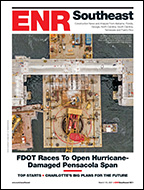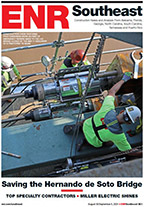“Even if they can make it (the girders) perfectly straight, a very serious study of the steel still needs to be done,” Cruz Noguez said. “Geometry is not everything.”
Bridge Opening in Peril
Replacing the girders could add another 9 to 12 months to the bridge project, said Laura McNabb, spokeswoman for the city's transportation department. That, in turn, could push off the opening of the new bridge, which had been slated for the fall of 2015, into the latter half of 2016.
A long delay, in turn, could have major ramifications for the team of contractors building the Edmonton bridge, which will replace an aging structure built in the early 1900s.
There are also penalties that kick in if the project is delivered after its contractual completion date, although city officials declined to give more details.
Liability for consequential delays is another multimillion-dollar question for all involved.
Edmonton officials say they are probing a range of causes, including environmental, with high winds reported during the early morning hours of Monday, March 16, when the girders buckled.
Construction crews actually started installing the girders on Friday night, but had to stop work on Saturday night due to high winds, according to city engineering officials.
When work finally resumed in the early morning hours of Monday, winds were up to 70 kilometers an hour and may have reached 120 kilometers per hour in the area of the bridge, which sits in a river valley that can act like a wind tunnel, according to a staffer for Edmonton Councilor Michael Oshry, who was briefed on the review.
Investigation of Causes
The city’s structural consultant is trying to “cross-tabulate” the impact of high winds with other potential factors, such as fabrication problems. The review is also looking at whether the designs were correct and whether the load being placed on the beams was distributed evenly, the councilor's staff member.
The city’s consultant is also looking closely at both the design of the braces used as the girders were bolted into place and erection procedures during the installation, city engineering officials confirmed.
However, doing the necessary tests and examinations of the girders and the bridge project won’t be easy given the bustling commuter roadway beneath. About 40,000 vehicles use the road each day.
That means engineers and other consultants brought in to investigate the incident will have limited hours to work within, either over the weekends or late at night, long after commuters have reached home, city officials say.
Given the restrictions, it could take weeks for the review to be completed.
“The contractors will continue working on a plan for a detailed analysis of the girders and lay out a new schedule for the project,” said Barry Belcourt, Edmonton’s manager of road design and construction, in a statement. “We will know more in the weeks ahead how construction will move forward.”



Post a comment to this article
Report Abusive Comment